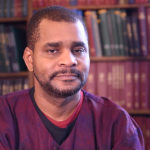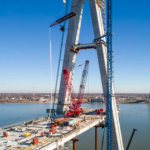In 1929, the longest suspended central span bridge in the world at that time – The Ambassador Bridge – was completed linking Detroit to Windsor, Ontario. It is the busiest United States/Canada truck crossing, handling 8,000+ trucks and 68,000 travelers a day.
One year later, the Detroit-Canada tunnel opened and now handles over 4 million vehicles per year.
In 2022 construction began for the Gordie Howe Bridge, which will provide uninterrupted freeway traffic flow between Detroit and Windsor, as opposed to the Ambassador Bridge that connects to city streets on the Ontario side. When completed, the bridge will be a 1.5-mile crossing – the longest cable-stayed bridge in North America – with a main span of .53 mile. The bridge will also feature a nearly 12-foot-wide pedestrian/cycling path.
These connections between the U.S. and Canada are iconic symbols of unity, catalysts for international relations, and facilitators of the economy. The new Gordie Howe Bridge is an additional symbol of progress.
But as we revel in the revitalization of Detroit and the area’s growth and vitality, it’s critically important to remember our history. Our Black history.

DETROIT HISTORIAN, JAMON JORDAN
Nearly 200 years ago, there was another unseen “bridge” in Detroit that was used to transport individuals to Canada for very different reasons. The “Bridge to Freedom” – the Underground Railroad – operated from roughly 1830 to 1865 and is estimated to have helped guide over 100,000 enslaved people to freedom.
Detroitisit tapped into Detroit’s Historian, Jamon Jordan for a history lesson on the deep impact the Underground Railroad had – and has – on Detroit and how it helped shape the city as well as thousands of people’s lives.
Here is what he told us, focusing on two – of many – pivotal occurrences:
Most people know that the Underground Railroad was not a railroad at all. Railroad was a term used to identify the people, places and routes that were used to help people escape from slavery. It was a code of sorts developed so that people could have clandestine conversations without being discovered and identified.
The “places” that made up the underground railroad were referred to as stations or depots. A station could be a house, church, barn, cellar, hidden room, or any number of spots to hide someone.
The “people” who made up the underground railroad were; Station Masters – the people in charge of hiding people; Conductors people who took people from one place to another; and Stockholders, people who donated resources such as food, clothing, wagons etc.
The “routes” were just that – and they led to places of freedom such as Mexico, the Caribbean, and Canada.
In Detroit, the underground railroad movement actually began prior to railroads existing. One of the most well-known stories goes back as early as 1807 and involves the Denison family. Peter and Hannah Denison and their four children were “owned” by Catherine and William Tucker. Eventually the Tucker’s freed Peter and Hannah but not their children. Peter and Hannah filed in Detroit to sue to free their children. Judge Augustus Woodward was the Chief Justice for the Michigan Territory at that time and ruled that anyone born after July 11, 1796 could not be enslaved.

TUNNEL TO CANADA
This did not free all of the Denison children. So eventually they escaped to Canada and Peter and Hannah acted as their own conductors for their children.
Woodward’s ruling though, essentially put an expiration date on slavery in Detroit and activity catapulted in the area afterward.
The story of Thornton and Lucy Blackburn marks another monumental event in Detroit in the early 1830s. The Blackburns escaped from slavery in Kentucky and came to Detroit where they lived for two years. In 1833, bounty hunters came to find them. The sheriff, deputy and circuit court judge assisted, and Lucy and Thornton were caught. However, there was a large uproar in the black community.
Thornton and Lucy were held in jail for a weekend, and some women visited Lucy in jail. A woman named Caroline French switched clothes with Lucy, and Lucy walked out unnoticed and went to Canada. She was free.
With over 400 abolitionists outside the jail, there was a scuffle when Thornton was escorted out, and Thornton got away and fled to Canada as well.
Thornton and Lucy then started a taxi service in Windsor and built five homes to house future slaves fleeing to Canada. Eventually, Thornton came back and, with help from others, rescued his mother and several others.
This group then started the Second Baptist Church in Detroit, which is the oldest black church in Michigan and one of the most used and most critical stops on the Underground Railroad.
While the Underground Railroad was led by African Americans, many whites were involved as well.
Some of the greatest leaders in Detroit included George DeBaptiste, William and Julia Lambert, William Webb, Henry Bibb, William Dolarson, Seymour Finney, Samual Zug, Zachariah Chandler, Jacob M. Howard, and many more.

GORDIE HOWE BRIDGE CONSTRUCTION
Jordan switches gears here, ending the history lesson and closing our conversation by connecting past to present.
He says, “Detroit and Windsor have long had this connection. In the 1800’s when the French came to Detroit and established the fur trade, the Beaubien, Rivard, Chene and Campas families had people living on both sides of the river and operating together. Much later, the auto industry emerged and the river was used for commerce and trade. Now the development of the Gordie Howe Bridge is reaffirming this long-held history of connection. A connection that represents so much, including freedom for thousands.”
As always, be sure to subscribe to our newsletter for regular updates on all things Detroit.






















